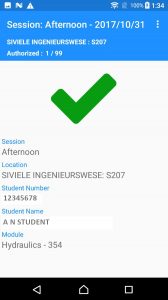Until recently granting access to examinations for students has been a manual and time-consuming process of checking-off access lists. However, thanks to new technology developed by Information Technology in collaboration with the Examination Office in the Registrar’s Division, this is no longer the case.
Since June this year, the identification of students for access to examination venues has been facilitated with the use of cell phones at each venue.
A student’s student card is held against the back of the cell phone, and on the screen, it is indicated whether the student is supposed to write the examination in the specific module in the specific venue. The screen will display a green mark if the student is at the correct exam venue (see image right) and a red cross if not. If the student is at the wrong venue, the screen will indicate where the student should be for the exam or test.
This will result in access to examination venues being easily and swiftly controlled and will certainly simplify and improve the function of access control with regard to examination venues.
This easier scanning process is made possible by the NFC (near-field communications) chip on Android phones which communicates with the MIFARE chip embedded in the student card, and the identification information is then used by the phone app to look up the student’s exam venue. The exam venue and module information come from the Student Information System.
Tests were first conducted on a small scale during the November 2017 examination and the technology was rolled out fully for the June 2018 examination. It was a resounding success.
Emce Louw, Head of the Exam Office experienced the impact first-hand as the process was driven from her office. This included loading the cell phones, setting up data, training the convenors responsible for scanning at the venues and collecting the phones after the exams. She received overwhelmingly positive feedback from invigilators and students alike:
“Scan van studentekaarte is fantasties! Ek het gister 4de jaar Megatronika studente gehad. Hulle was vreeslik beïndruk met die scanning!”
The development and successful completion of the technology was a cross-functional team effort. Hendrik le Roux from Information Technology’s Access Control Division was the project manager and Guzelle Hendricks was responsible for business analysis for the two three-month phases of the project which ran from the end of 2017 to June 2018.
In addition to Hendrik and Guzelle the following staff played a key role in getting the project off the ground – Phillip Greeff (TAS), Gregory Isaacs (TAS), Anna-Mari du Toit, Marc-Allen Johnson, Jeremy van Rooyen, Charles Hopkins, who wrote the app and Elmar Matthee who was responsible for the back-end development. On the side of the functional stakeholders, besides for Emce, Neels Fourie (Deputy Registrar), and Jan du Toit and Helene Nieuwoudt (both from SISS) participated in the project.



